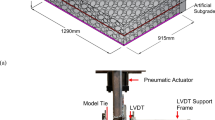Abstract
The behaviour of concrete beams under impact loading was studied, using an instrumented drop-weight impact apparatus capable of dropping a 345 kg mass from heights of up to 3 m. Both plain and conventionally reinforced beams, with overall dimensions (length x width x depth) of 1,400×100×125 mm, were tested on a 960 mm span, with the impact load applied at mid-span. The load on the instrumented striking tup, and the acceleration of the beam itself, were measured as a function of time; the entire impact events had a duration of 10 to 70 ms. This paper describes the methods used to analyze the impact data, as well as some preliminary results.
Résumé
On a étudié le comportement de poutres de béton sous charge de choc à l’aide d’un appareil à mouton en chute libre qui peut libérer une masse de 345 kg avec des hauteurs de chute jusqu’à 3 m. On a essayé à la fois des poutres de béton non armé et armé conventionnellement, de dimensions générales (longuer x largeur x profondeur) de 1400×100×125 mm, la charge de choc étant appliquée au milieu d’une portée d’essai de 960 mm. On a mesuré comme une fonction du temps la charge au moment de sa mise en action et au moment de l’impact; la durée totale de l’action était de 10 à 70 m/s.
Sur la base des résultats et de l’analyse, on peut tirer les conclusions suivantes:
-
1.
Même pour des vitesses de choc relativement basses adoptées dans ces essais (∼3 m/s), la valeur de pic se produisait dans un délai de ` m/s après l’impact.
-
2.
L’utilisation des accéléromètres montés sur les poutres peut servir à évaluer la charge d’inertie, ainsi que les vitesses et accélérations repaires.
-
3.
La charge d’inertie correspondant à la charge de pic mesurée peut s’élever à plus des 2/3 de la charge totale.
-
4.
La rupture à imputer à la charge d’inertie peut conduire à des conclusions erronées.
-
5.
Les évaluations de l’énergie à partir des charges appliquées par le mouton mis en œuvre ne concordent pas bien avec la somme de l’énergie cinétique calculée et de l’énergie dépensée pour fléchir et fracturer la poutre.
Similar content being viewed by others

References
Suaris W., Shah S. P.—Inertial effects of the instrumented impact testing of cementitious composites, Cement, Concrete, and Aggregates, Vol. 3, No. 2, 1981, pp. 77–83.
Server W. L.—Impact three-point bend testing for notched and precracked specimens, Journal of Testing and Evaluation, Vol. 6, No. 1, 1978, pp. 29–34.
Suaris W., Shah S. P.—Properties of concrete subjected to impact, Journal of Structural Engineering, ASCE, Vol. 109, No. 7, 1983, pp. 1727–1741.
Naaman A. E., Gopalaratnam V. S.—Impact properties of steel fibre reinforced concrete in bending, International Journal of Cement-Composites and Lightweight Concrete, Vol. 5, No. 4, 1983, pp. 225–233.
Gopalaratnam V. S., Shah, S. P., John R.—A modified instrumented Charpy test for cement based composites, Experimental Mechanics, Vol. 24, No. 2, 1984, pp. 102–111.
Mindess S., Bentur A.—A preliminary study of the fracture of concrete beams under impact loading, using high speed photography, Cement and Concrete Research, Vol. 15, No. 3, 1985, pp.474–484.
Mindess S., Banthia N., Ritter A., Skalny J. P.—Crack development in cementitious materials under impact loading, inMindess S., Shah S. P. Eds.,Cement-based composites: strain rate effects on fracture, Materials Research Society Symposium Proceedings, Vol. 64, Materials Research Society, Pittsburgh, 1986, pp. 217–223.
Author information
Authors and Affiliations
Additional information
This work was carried out while Dr. Bentur was a Visiting Associate Professor in the Department of Civil Engineering, University of British Columbia.
Rights and permissions
About this article
Cite this article
Bentur, A., Mindess, S. & Banthia, N. The behaviour of concrete under impact loading: Experimental procedures and method of analysis. Materials and Structures 19, 371–378 (1986). https://doi.org/10.1007/BF02472127
Issue Date:
DOI: https://doi.org/10.1007/BF02472127



